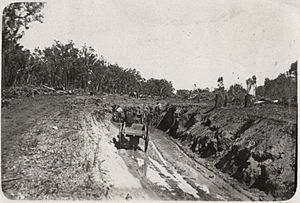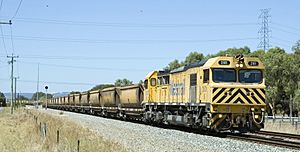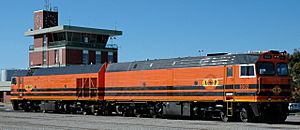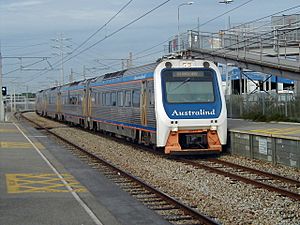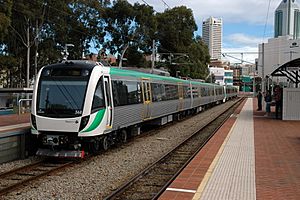Rail transport in Western Australia facts for kids
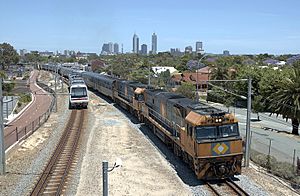
Railways in Western Australia help people and goods travel across the state. The first railways were built in the 1800s by the government and private companies. Today, the Public Transport Authority (PTA) runs passenger trains. This includes Transperth for city travel in Perth and Transwa for country trips. The famous Indian Pacific train, which travels across Australia, is run by Journey Beyond.
The main railway line that goes east from Kalgoorlie to other states is owned by the Australian Rail Track Corporation. Most other railway lines in Western Australia are managed by Arc Infrastructure. Freight trains, which carry goods, became private in 2000. Companies like Aurizon, Pacific National, and SCT Logistics now move goods like grain and minerals. In the Pilbara region, big mining companies have their own private railways to carry iron ore.
Contents
History of Western Australian Railways
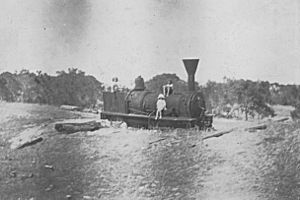
Early railways in Western Australia used a "narrow gauge" track, which is 3 ft 6 in (1,067 mm) wide. These lines started from port cities like Fremantle, Geraldton, Bunbury, Albany, and Esperance. They were mainly used to transport grain and minerals. Some private companies also built narrow gauge lines, often getting land from the government to help them.
In 1907, plans were made for a "standard gauge" railway, which is 1,435 mm (4 ft 8 1⁄2 in) wide. This line, called the Trans-Australian Railway, would connect Port Augusta in South Australia to Kalgoorlie in Western Australia. Building started in 1912 and finished in 1917. The Commonwealth Railways ran it.
In the 1960s, standard gauge lines reached Perth and Esperance. Also, very long and heavy-haul railways were built in the Pilbara region by big iron mining companies like BHP and Hamersley Iron. Around this time, Perth's city train lines were updated and made electric.
The government railways were first managed by the Department of Works and Railways starting in 1877. This department became the Western Australian Government Railways (WAGR) in 1890. Later, in 1975, WAGR changed its name to Westrail. Westrail managed both passenger and freight services until 2000. That's when the freight part of the business was sold to a private company. The remaining parts of Westrail, like owning the rail network and running regional passenger services, were taken over by the Public Transport Authority in 2003. They now run passenger services under the Transwa name.
Key Dates in Railway History
- 1871: The private Ballaarat Tramline opens, carrying timber south of Perth.
- 1879: The first government railway opens between Geraldton and Northampton to move lead and copper.
- 1881: The Eastern line opens, connecting Fremantle to Perth and Guildford.
- 1893: The South Western line connects Perth to Bunbury.
- 1894: The Midland Railway Company opens its Midland line, linking Midland Junction to Walkaway.
- 1896: The Eastern Goldfields line reaches Kalgoorlie, important for gold mining.
- 1917: The standard gauge Trans-Australian Railway connects Western Australia with eastern Australia.
- 1968: A new standard gauge line opens from Kalgoorlie to Perth.
- 1970: The first Indian Pacific train service runs from Perth to Sydney.
- 1986: Perth's city train lines start to be electrified, using electric power from overhead wires.
- 1993: The Northern Suburbs Transit System begins, with a new line to Joondalup.
- 2007: The Mandurah line opens as part of the New MetroRail project, expanding Perth's network.
- 2017: Metronet is created to plan and build more extensions to Perth's rail system.
- 2022: The Forrestfield-Airport link opens, connecting Perth Airport to the train network.
How Railways First Grew
The very first private railways were built south of Perth in 1871 to carry timber. One ran from Lockville (near Busselton) to Yoganup. Another went from Rockingham to Jarrahdale.
The first government railway opened in 1879. It was a narrow gauge line between Geraldton and Northampton. Its main job was to move lead and copper from mines to the port. This line closed in 1957.
The WAGR opened the Eastern line from Fremantle to Perth and Guildford in 1881. This line was extended over the years, reaching places like York and Beverley. Branch lines were also built to connect other towns.
The Beverley line was extended to Albany in 1889 by a private company, which the WAGR later took over. The South Western Railway connected Perth to Bunbury in 1893, with branches to places like Collie.
In the north, the Midland Railway Company opened a line from Midland Junction to Walkaway in 1894. This connected with the WAGR line from Geraldton. The WAGR bought this line in 1964.
The line to the Goldfields was very important. It reached Coolgardie and Kalgoorlie in 1896. This line later connected with the standard gauge Trans-Australian Railway in 1917, which linked Western Australia to the eastern states.
Some railways were built just to serve specific areas, like the Marble Bar Railway in the Pilbara region (opened 1911, closed 1951) and the Hopetoun to Ravensthorpe railway (opened 1909, closed 1935). These were "isolated" because they weren't connected to the main network.
How Railways Operate Today
Perth's City Train Network
Perth's city train system, run by Transperth, has grown a lot. In 1982, after public protests, the Fremantle railway reopened. This marked the start of a new focus on improving city trains. By 1991, Perth's existing train lines were made electric, using modern electric trains.
In 1993, the Northern Suburbs Transit System started running. Then, in 2007, the big New MetroRail project finished. This added the Mandurah line and other important connections, making it easier for people to travel around Perth.
Regional Passenger Trains
Transwa manages passenger train services that go outside of Perth. These trains connect Perth to places like Kalgoorlie, Northam, and Bunbury. The trains have special names: the Prospector, AvonLink, and Australind.
The Indian Pacific is a famous long-distance train operated by Great Southern Rail. It travels all the way from Perth to Adelaide and Sydney.
Pilbara Iron Ore Railways

In the Pilbara region, there are four special heavy-duty railways. These are private lines used only to carry iron ore from mines to the ports. They are not connected to the main public rail network. These lines use massive trains and have helped develop new ways to make railways work better worldwide.
Some of the major iron ore railways include:
- Hamersley & Robe River railway (run by Rio Tinto)
- Mount Newman railway (run by BHP)
- Goldsworthy railway (run by BHP)
- Fortescue railway (run by FMG)
In 2008, Fortescue Metals Group opened its Fortescue railway from the Cloud Break mine to Port Hedland. More recently, in 2016, Hancock Prospecting opened a line from its Roy Hill project. These companies are always looking to expand their rail lines to meet the high demand for iron ore.
Bringing Perth's Railways Back to Life
Not long ago, Perth's train system wasn't as popular or well-supported as it is today. In the early 1980s, a railway line connecting the city to Fremantle was even closed in 1979 to make way for a new road.
However, a group of people, including Professor Peter Newman, fought to save the railway land. They succeeded in 1983, and the Fremantle line was reopened. This event changed how people thought about public transport in Perth.
After this, in 1986, the first plan for improving the rail system was made. People, planners, and politicians started to prefer building new train lines instead of just more roads. They wanted a new rail system to connect Perth to the northern suburbs.
Since then, many plans have been made to improve and expand Perth's city train system. These plans have led to new tracks and modern trains. The number of people using the Perth to Fremantle train line has grown a lot. In fact, the daily number of journeys on this single line (about 23,000) is now almost as high as the total number of journeys on all city lines in 1989.
This shift shows that Perth has moved away from relying only on cars and roads. Now, the city is focusing on expanding its train system and creating "Liveable Neighbourhood" policies. These policies encourage mixed housing, walkable communities, and sustainable ways to travel.


